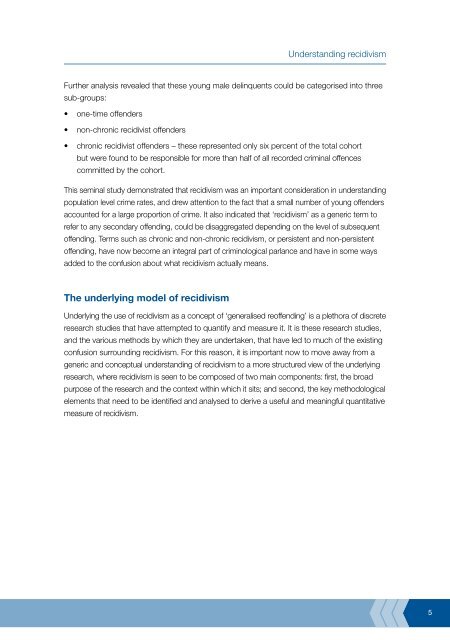Recidivism in Australia : findings and future research - Australian ...
Recidivism in Australia : findings and future research - Australian ...
Recidivism in Australia : findings and future research - Australian ...
Create successful ePaper yourself
Turn your PDF publications into a flip-book with our unique Google optimized e-Paper software.
Underst<strong>and</strong><strong>in</strong>g recidivism<br />
Further analysis revealed that these young male del<strong>in</strong>quents could be categorised <strong>in</strong>to three<br />
sub-groups:<br />
•<br />
•<br />
•<br />
one-time offenders<br />
non-chronic recidivist offenders<br />
chronic recidivist offenders – these represented only six percent of the total cohort<br />
but were found to be responsible for more than half of all recorded crim<strong>in</strong>al offences<br />
committed by the cohort.<br />
This sem<strong>in</strong>al study demonstrated that recidivism was an important consideration <strong>in</strong> underst<strong>and</strong><strong>in</strong>g<br />
population level crime rates, <strong>and</strong> drew attention to the fact that a small number of young offenders<br />
accounted for a large proportion of crime. It also <strong>in</strong>dicated that ‘recidivism’ as a generic term to<br />
refer to any secondary offend<strong>in</strong>g, could be disaggregated depend<strong>in</strong>g on the level of subsequent<br />
offend<strong>in</strong>g. Terms such as chronic <strong>and</strong> non-chronic recidivism, or persistent <strong>and</strong> non-persistent<br />
offend<strong>in</strong>g, have now become an <strong>in</strong>tegral part of crim<strong>in</strong>ological parlance <strong>and</strong> have <strong>in</strong> some ways<br />
added to the confusion about what recidivism actually means.<br />
The underly<strong>in</strong>g model of recidivism<br />
Underly<strong>in</strong>g the use of recidivism as a concept of ‘generalised reoffend<strong>in</strong>g’ is a plethora of discrete<br />
<strong>research</strong> studies that have attempted to quantify <strong>and</strong> measure it. It is these <strong>research</strong> studies,<br />
<strong>and</strong> the various methods by which they are undertaken, that have led to much of the exist<strong>in</strong>g<br />
confusion surround<strong>in</strong>g recidivism. For this reason, it is important now to move away from a<br />
generic <strong>and</strong> conceptual underst<strong>and</strong><strong>in</strong>g of recidivism to a more structured view of the underly<strong>in</strong>g<br />
<strong>research</strong>, where recidivism is seen to be composed of two ma<strong>in</strong> components: first, the broad<br />
purpose of the <strong>research</strong> <strong>and</strong> the context with<strong>in</strong> which it sits; <strong>and</strong> second, the key methodological<br />
elements that need to be identified <strong>and</strong> analysed to derive a useful <strong>and</strong> mean<strong>in</strong>gful quantitative<br />
measure of recidivism.<br />
5















